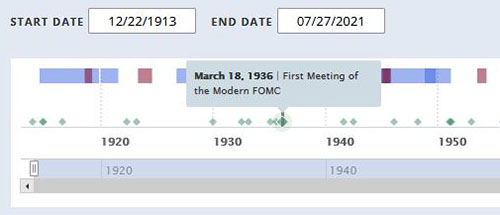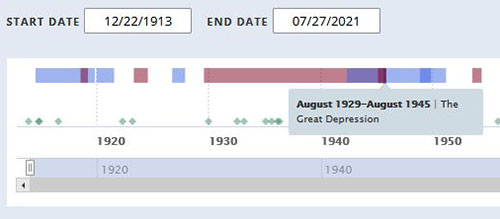FRASER’s timelines are created to chronicle historical events related to the Federal Reserve System, document the history of the Federal Reserve banks, and cover broader subjects in economic and banking history. To add context and enhance understanding of these events, collections of primary source materials are carefully curated to include relevant events and time periods documented within the timelines. These unique and fascinating collections are another of the many tools created within FRASER to help develop a deeper understanding of economic, banking, and Federal Reserve history.
Over its more than 100-year history, the Federal Reserve has made significant innovations in the understanding and use of monetary policy. With our new Federal Reserve Monetary Policy Timeline, you can now browse decades of events in the development of the Fed’s monetary policy toolbox and communications alongside related primary source documents and archival materials. The timeline project is a collaboration among staff from FRASER, FederalReserveHistory.org, and the St. Louis Fed Research Library as well as St. Louis Fed economic education curriculum experts and Fed economists.


Monetary policy developed slowly throughout the Fed’s first 20 years. The 1913 Federal Reserve Act made no mention of the phrase “monetary policy,” although its purpose “to furnish an elastic currency” is part of what the Fed does today. The first edition of the System’s aptly named publication “Purposes and Functions” published in 1939 focused primarily on bank reserves and services to member banks. The phrase “monetary policy” is nowhere to be found until the third edition published in 1954.
The timeline moves through the first coordinated open market purchases spearheaded by Federal Reserve Bank of New York leader Benjamin Strong as the 1920s began their economic roar. In the 1930s, the lack of a mature concept of monetary policy or effective tools to combat the sharp contractions of the Great Depression led Congress to amend the Federal Reserve Act with laws including the Banking Act of 1935, which reorganized the Federal Reserve and created the modern FOMC.

It was only in 1936, after the Banking Act of 1935 went into effect, that the FOMC as we know it took shape. The economic complications of World War II and the tensions between the Fed and the Treasury department contributed to a Fed that was more focused on financing the government than controlling inflation.
The more independent Fed of the 1950s led to the monetary policy stance expressed in Chair William McChesney Martin Jr.’s famous “punch bowl” speech in October 1955. Over the next few decades, the Fed evolved, the U.S. economy evolved, and economics evolved with them. The St. Louis Fed pioneered the sharing of monetary data to inform the policymaking process. As the postwar boom gave way to the “stagflation” of the 1970s, Congress mandated a new twice-yearly monetary policy report to Congress with the Humphrey-Hawkins Act. (Although that law has expired and the reports are no longer required, the Fed still gives its reports and testimony to Congress every year.)
The FOMC’s unprecedented surprise policy action in October 1979 under new Fed Chair Paul Volcker was one of a series of legal and policy changes in how the Fed conducts monetary policy and its everyday functions. Later, in response to the Financial Crisis of 2007-2009, the Fed would again make an unprecedented move, setting the lower end of the federal funds rate target range to zero.
As the Fed’s monetary policy continues to change and grown alongside the U.S. economy, the timeline will be updated with further events and possibly newly defined historical eras. Teachers, students, and researchers of all kinds can use the timeline and its list of related resources (including the new classroom resource collection Teaching the New Tools of Monetary Policy) to learn more about today’s monetary policy and the path the Fed has taken.
© 2022, Federal Reserve Bank of St. Louis. The views expressed are those of the author(s) and do not necessarily reflect official positions of the Federal Reserve Bank of St. Louis or the Federal Reserve System.


 @FedFRASER
@FedFRASER